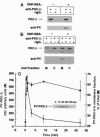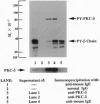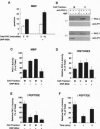Abstract
The delta isoform of protein kinase C is phosphorylated on tyrosine in response to antigen activation of the high-affinity receptor for immunoglobulin E. While protein kinase C-delta associates with and phosphorylates this receptor, immunoprecipitation of the receptor revealed that little, if any, tyrosine-phosphorylated protein kinase C-delta is receptor associated. In vitro kinase assays with immunoprecipitated tyrosine-phosphorylated protein kinase C-delta showed that the modified enzyme had diminished activity toward the receptor gamma-chain peptide as a substrate but not toward histones or myelin basic protein peptide. We propose a model in which the tyrosine phosphorylation of protein kinase C-delta regulates the kinase specificity toward a given substrate. This may represent a general mechanism by which in vivo protein kinase activities are regulated in response to external stimuli.
Full text
PDF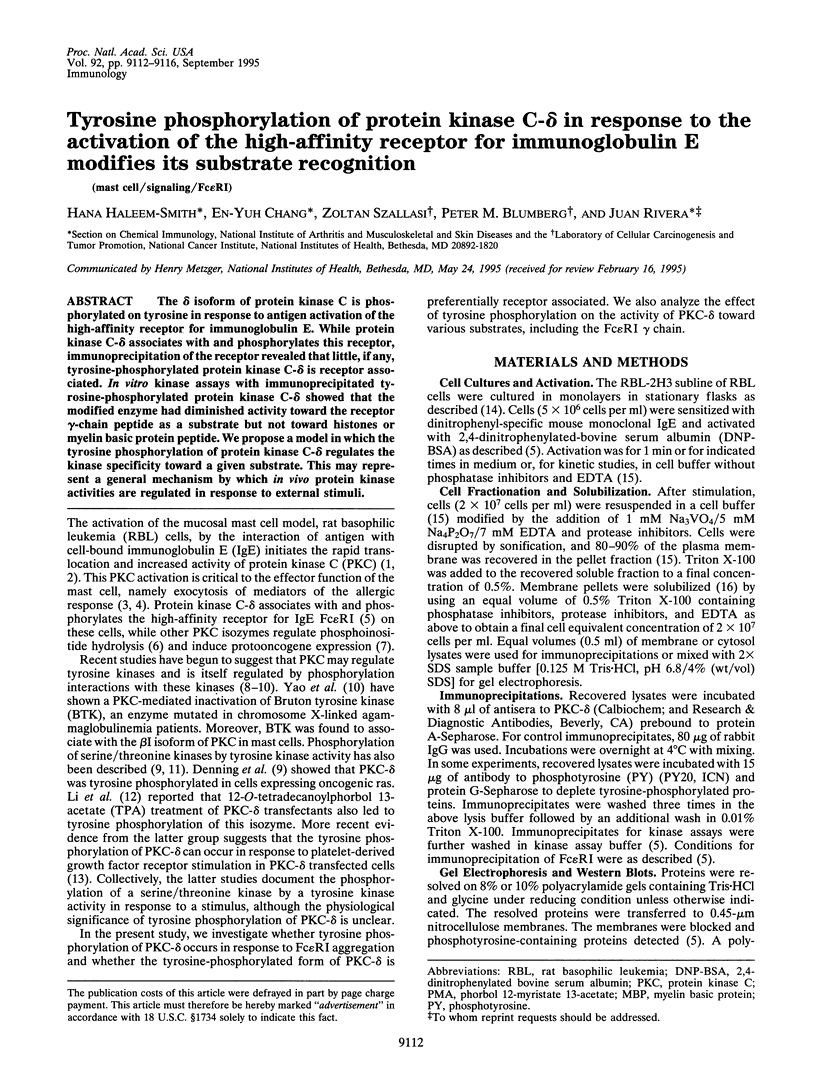
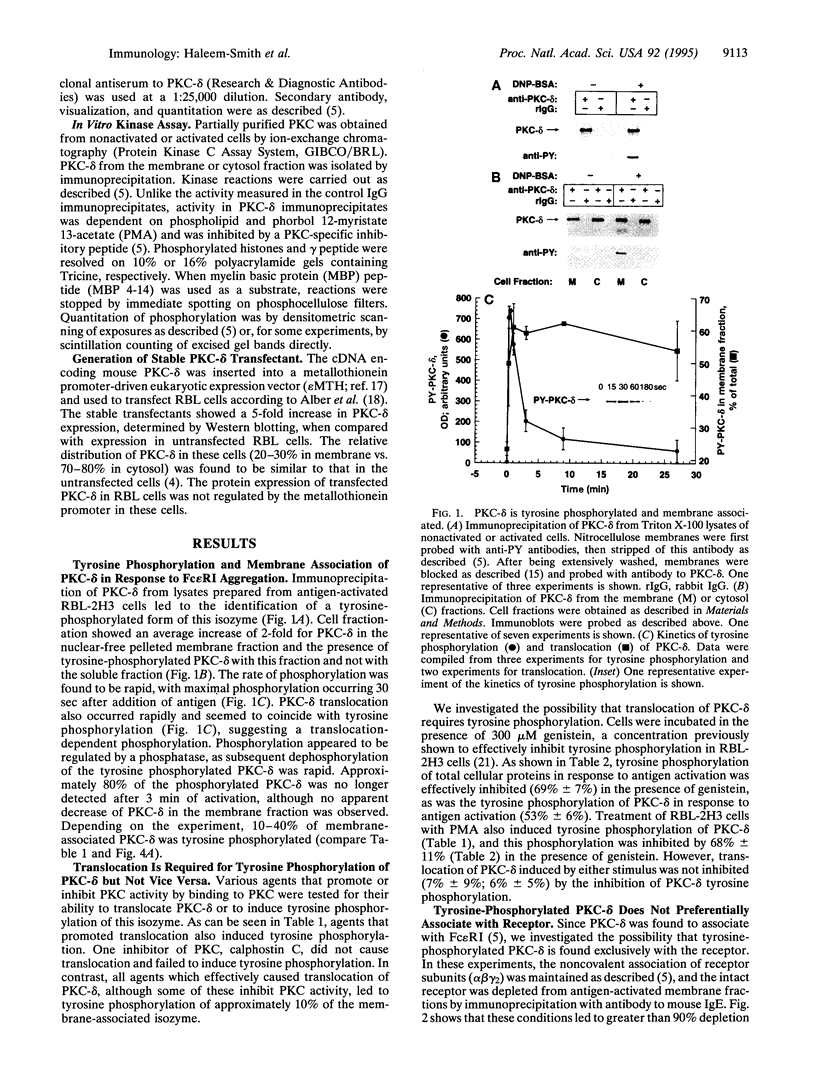
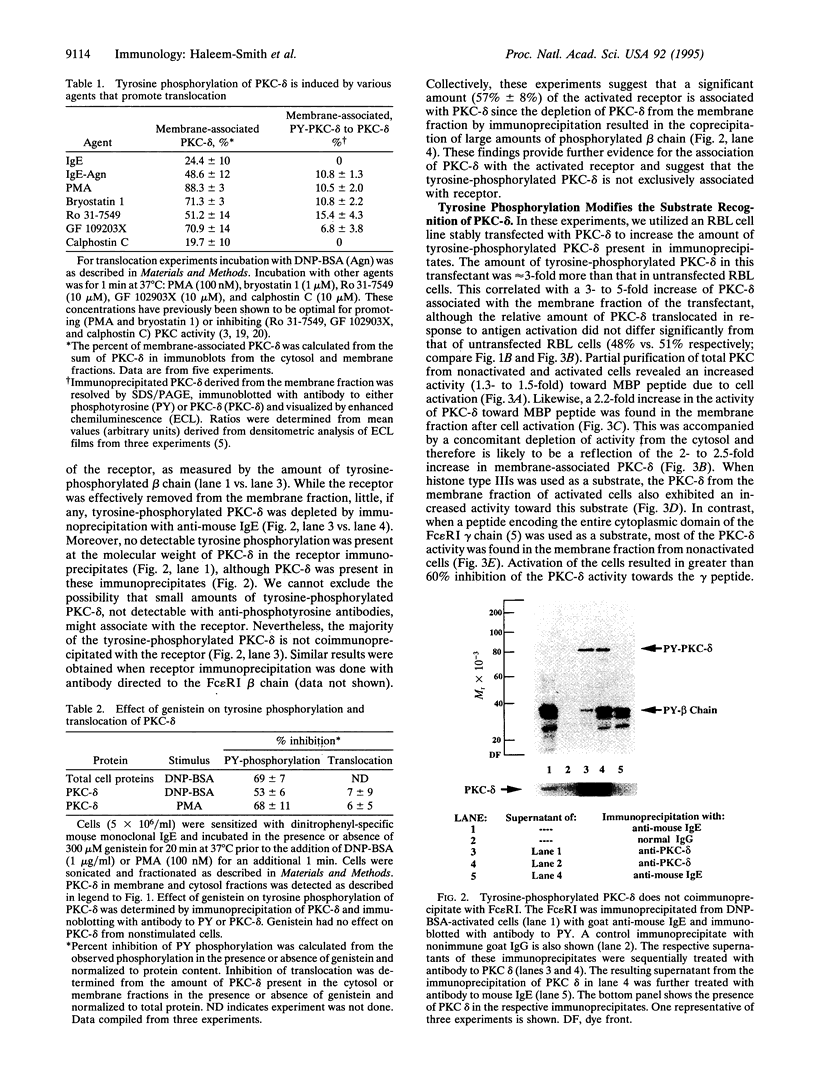
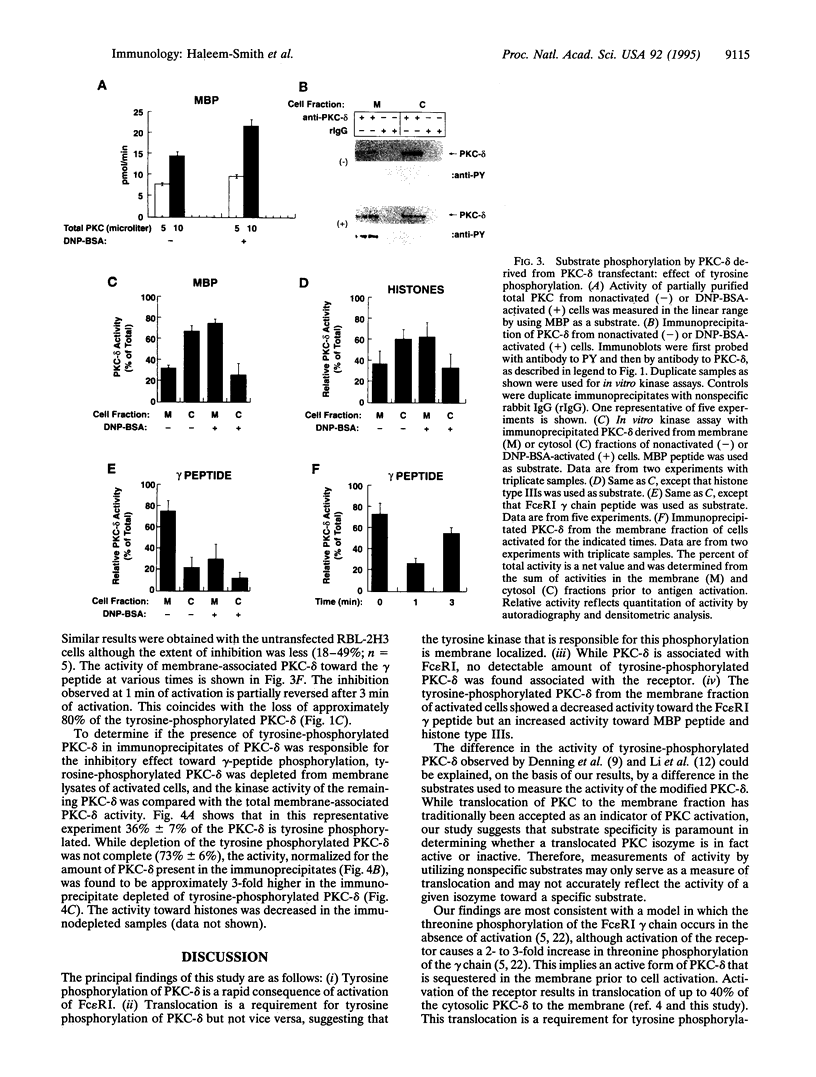
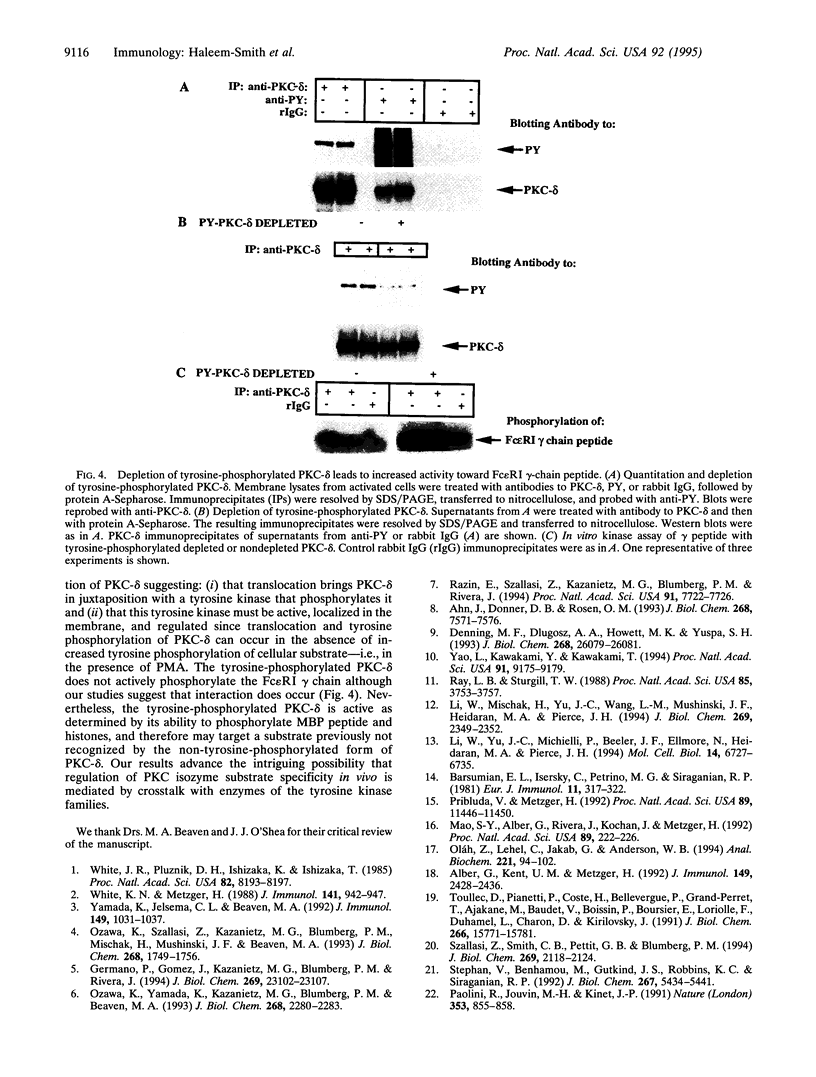
Images in this article
Selected References
These references are in PubMed. This may not be the complete list of references from this article.
- Ahn J., Donner D. B., Rosen O. M. Interaction of the human insulin receptor tyrosine kinase from the baculovirus expression system with protein kinase C in a cell-free system. J Biol Chem. 1993 Apr 5;268(10):7571–7576. [PubMed] [Google Scholar]
- Alber G., Kent U. M., Metzger H. Functional comparison of Fc epsilon RI, Fc gamma RII, and Fc gamma RIII in mast cells. J Immunol. 1992 Oct 1;149(7):2428–2436. [PubMed] [Google Scholar]
- Barsumian E. L., Isersky C., Petrino M. G., Siraganian R. P. IgE-induced histamine release from rat basophilic leukemia cell lines: isolation of releasing and nonreleasing clones. Eur J Immunol. 1981 Apr;11(4):317–323. doi: 10.1002/eji.1830110410. [DOI] [PubMed] [Google Scholar]
- Denning M. F., Dlugosz A. A., Howett M. K., Yuspa S. H. Expression of an oncogenic rasHa gene in murine keratinocytes induces tyrosine phosphorylation and reduced activity of protein kinase C delta. J Biol Chem. 1993 Dec 15;268(35):26079–26081. [PubMed] [Google Scholar]
- Germano P., Gomez J., Kazanietz M. G., Blumberg P. M., Rivera J. Phosphorylation of the gamma chain of the high affinity receptor for immunoglobulin E by receptor-associated protein kinase C-delta. J Biol Chem. 1994 Sep 16;269(37):23102–23107. [PubMed] [Google Scholar]
- Li W., Mischak H., Yu J. C., Wang L. M., Mushinski J. F., Heidaran M. A., Pierce J. H. Tyrosine phosphorylation of protein kinase C-delta in response to its activation. J Biol Chem. 1994 Jan 28;269(4):2349–2352. [PubMed] [Google Scholar]
- Li W., Yu J. C., Michieli P., Beeler J. F., Ellmore N., Heidaran M. A., Pierce J. H. Stimulation of the platelet-derived growth factor beta receptor signaling pathway activates protein kinase C-delta. Mol Cell Biol. 1994 Oct;14(10):6727–6735. doi: 10.1128/mcb.14.10.6727. [DOI] [PMC free article] [PubMed] [Google Scholar]
- Mao S. Y., Alber G., Rivera J., Kochan J., Metzger H. Interaction of aggregated native and mutant IgE receptors with the cellular skeleton. Proc Natl Acad Sci U S A. 1992 Jan 1;89(1):222–226. doi: 10.1073/pnas.89.1.222. [DOI] [PMC free article] [PubMed] [Google Scholar]
- Oláh Z., Lehel C., Jakab G., Anderson W. B. A cloning and epsilon-epitope-tagging insert for the expression of polymerase chain reaction-generated cDNA fragments in Escherichia coli and mammalian cells. Anal Biochem. 1994 Aug 15;221(1):94–102. doi: 10.1006/abio.1994.1384. [DOI] [PubMed] [Google Scholar]
- Ozawa K., Szallasi Z., Kazanietz M. G., Blumberg P. M., Mischak H., Mushinski J. F., Beaven M. A. Ca(2+)-dependent and Ca(2+)-independent isozymes of protein kinase C mediate exocytosis in antigen-stimulated rat basophilic RBL-2H3 cells. Reconstitution of secretory responses with Ca2+ and purified isozymes in washed permeabilized cells. J Biol Chem. 1993 Jan 25;268(3):1749–1756. [PubMed] [Google Scholar]
- Ozawa K., Yamada K., Kazanietz M. G., Blumberg P. M., Beaven M. A. Different isozymes of protein kinase C mediate feedback inhibition of phospholipase C and stimulatory signals for exocytosis in rat RBL-2H3 cells. J Biol Chem. 1993 Feb 5;268(4):2280–2283. [PubMed] [Google Scholar]
- Paolini R., Jouvin M. H., Kinet J. P. Phosphorylation and dephosphorylation of the high-affinity receptor for immunoglobulin E immediately after receptor engagement and disengagement. Nature. 1991 Oct 31;353(6347):855–858. doi: 10.1038/353855a0. [DOI] [PubMed] [Google Scholar]
- Pribluda V. S., Metzger H. Transmembrane signaling by the high-affinity IgE receptor on membrane preparations. Proc Natl Acad Sci U S A. 1992 Dec 1;89(23):11446–11450. doi: 10.1073/pnas.89.23.11446. [DOI] [PMC free article] [PubMed] [Google Scholar]
- Ray L. B., Sturgill T. W. Insulin-stimulated microtubule-associated protein kinase is phosphorylated on tyrosine and threonine in vivo. Proc Natl Acad Sci U S A. 1988 Jun;85(11):3753–3757. doi: 10.1073/pnas.85.11.3753. [DOI] [PMC free article] [PubMed] [Google Scholar]
- Razin E., Szallasi Z., Kazanietz M. G., Blumberg P. M., Rivera J. Protein kinases C-beta and C-epsilon link the mast cell high-affinity receptor for IgE to the expression of c-fos and c-jun. Proc Natl Acad Sci U S A. 1994 Aug 2;91(16):7722–7726. doi: 10.1073/pnas.91.16.7722. [DOI] [PMC free article] [PubMed] [Google Scholar]
- Stephan V., Benhamou M., Gutkind J. S., Robbins K. C., Siraganian R. P. Fc epsilon RI-induced protein tyrosine phosphorylation of pp72 in rat basophilic leukemia cells (RBL-2H3). Evidence for a novel signal transduction pathway unrelated to G protein activation and phosphatidylinositol hydrolysis. J Biol Chem. 1992 Mar 15;267(8):5434–5441. [PubMed] [Google Scholar]
- Szallasi Z., Smith C. B., Pettit G. R., Blumberg P. M. Differential regulation of protein kinase C isozymes by bryostatin 1 and phorbol 12-myristate 13-acetate in NIH 3T3 fibroblasts. J Biol Chem. 1994 Jan 21;269(3):2118–2124. [PubMed] [Google Scholar]
- Toullec D., Pianetti P., Coste H., Bellevergue P., Grand-Perret T., Ajakane M., Baudet V., Boissin P., Boursier E., Loriolle F. The bisindolylmaleimide GF 109203X is a potent and selective inhibitor of protein kinase C. J Biol Chem. 1991 Aug 25;266(24):15771–15781. [PubMed] [Google Scholar]
- White J. R., Pluznik D. H., Ishizaka K., Ishizaka T. Antigen-induced increase in protein kinase C activity in plasma membrane of mast cells. Proc Natl Acad Sci U S A. 1985 Dec;82(23):8193–8197. doi: 10.1073/pnas.82.23.8193. [DOI] [PMC free article] [PubMed] [Google Scholar]
- White K. N., Metzger H. Translocation of protein kinase C in rat basophilic leukemic cells induced by phorbol ester or by aggregation of IgE receptors. J Immunol. 1988 Aug 1;141(3):942–947. [PubMed] [Google Scholar]
- Yamada K., Jelsema C. L., Beaven M. A. Certain inhibitors of protein serine/threonine kinases also inhibit tyrosine phosphorylation of phospholipase C gamma 1 and other proteins and reveal distinct roles for tyrosine kinase(s) and protein kinase C in stimulated, rat basophilic RBL-2H3 cells. J Immunol. 1992 Aug 1;149(3):1031–1037. [PubMed] [Google Scholar]
- Yao L., Kawakami Y., Kawakami T. The pleckstrin homology domain of Bruton tyrosine kinase interacts with protein kinase C. Proc Natl Acad Sci U S A. 1994 Sep 13;91(19):9175–9179. doi: 10.1073/pnas.91.19.9175. [DOI] [PMC free article] [PubMed] [Google Scholar]



